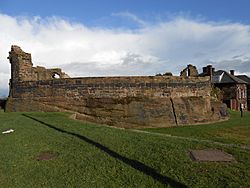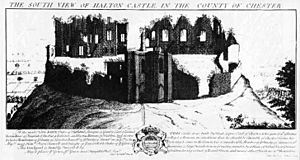Halton Castle facts for kids
Quick facts for kids Halton Castle |
|
|---|---|

Part of Halton Castle ruins in 2006
|
|
| Location | Halton, Runcorn, Cheshire, England |
| OS grid reference | SJ 537,821 |
| Built | 11th century |
| Built for | Hugh d'Avranches, Earl of Chester |
| Architectural style(s) | Castle |
| Governing body | Norton Priory Museum Trust |
| Owner | Duchy of Lancaster |
|
Listed Building – Grade I
|
|
| Designated | 23 April 1970 |
| Reference no. | 1130460 |
| Designated | 26 November 1963 |
| Reference no. | 1015606 |
| Lua error in Module:Location_map at line 420: attempt to index field 'wikibase' (a nil value). | |
Halton Castle is an old castle in the village of Halton. This village is part of the town of Runcorn, in Cheshire, England. The castle sits on top of Halton Hill, a large sandstone hill that looks over the village.
The first castle here was a "motte and bailey" type. This means it had a raised earth mound (motte) with a wooden tower. It also had a fenced area (bailey) below. This first castle was started in 1071. Later, in the 13th century, a new castle made of sandstone was built. Changes to the castle continued until at least 1609. By then, parts of it were already falling apart.
Halton Castle is a very important historical site. It is listed as a Grade I building and a scheduled ancient monument. This means it is protected because of its special history.
For many years, from the 11th to the 14th century, the castle was home to the Barons of Halton. After that, it became the property of the Duchy of Lancaster. During the English Civil War, the castle was attacked twice. After these attacks, its structure became very damaged. In the 1700s, a new courthouse was built where the old gatehouse used to be. Today, most of the castle is in ruins. However, the old courthouse has been turned into a public house, which is like a pub or hotel.
Contents
History of Halton Castle
How the Castle Began
People lived on Halton Hill a very long time ago, even before the castle was built. The castle's story began in 1071. That's when Hugh d'Avranches, Earl of Chester, gave the land to a man named Nigel of Cotentin. Nigel then built the first castle, which was a wooden motte and bailey castle.
In the 1200s, this wooden castle was replaced. Workers built a stronger castle using sandstone, which is what you see today. The castle became property of the Duchy of Lancaster when the 15th baron, Henry Bolingbroke, became King Henry IV.
Royal Visits and Changes
Many important people visited Halton Castle. In 1207, King John came to the castle. He even gave money to help fix its chapel. Later, in November 1323, King Edward II stayed at the castle for three days. He also visited a nearby place called Norton Priory.
Between 1450 and 1457, a new gate tower was added to the castle. During the Tudor period (a time in English history), the castle was used for different things. It was mainly a prison, a place for managing local affairs, and a court of law. In 1580–81, the castle was used to hold Catholic people who did not follow the official church. By 1609, a report on royal buildings said the castle was already in bad shape.
The Civil War Years
When the English Civil War started, soldiers loyal to the King (called Royalists) took control of Halton Castle. Captain Walter Primrose was in charge of these soldiers. In 1643, soldiers who supported Parliament (called Roundheads) attacked the castle. Their leader was Sir William Brereton. After several weeks of fighting, the Royalists gave up.
However, the Royalists soon took the castle back. This happened when the Parliamentarians left to fight Prince Rupert's forces elsewhere. There was another attack on the castle in 1644. But as the Royalists started losing battles in other places, they left Halton. Sir William Brereton's Parliamentarian forces then took over the castle again.
In 1646, a meeting was held where it was decided to break down the defenses of Halton Castle. The castle was no longer used for military purposes after this. By 1650, people said the castle was "very ruined."
What Happened Later
The castle continued to fall apart over time. However, the gatehouse was still used as a court. In 1728, George Cholmondeley, 2nd Earl of Cholmondeley, rented the castle site from the Crown. In 1737, a new courthouse was built where the old medieval gatehouse stood.
The first floor of this new building was the courtroom. Prisoners were kept in the basement. By 1792, the courthouse also needed repairs. The court continued to work there until 1908.
Around 1800, some extra walls were added to the ruined parts of the castle. These were "folly walls," meaning they were built to make the castle look more impressive. They were meant to be seen from Norton Priory, which was the home of Sir Richard Brooke. One of these walls was taken down around 1906. In the Victorian era, a special sunken garden and two bowling greens were built inside the castle area.
In 1977, the castle was rented to Halton Borough Council. From 1986 to 1987, archaeologists dug up parts of the castle site to learn more about its past.
Halton Castle Today
The Duchy of Lancaster still owns Halton Castle. The Norton Priory Museum Trust now looks after the site. Sometimes, the inside of the castle is opened for visitors. There are plans to make it easier for people to visit in the future.
The castle is a Grade I listed building, meaning it's very important. Its walls are mostly in ruins, but the outer shape is still complete. You can walk all the way around the outside of the castle. From its high spot, you can see amazing views in every direction. You can see parts of Lancashire, Cheshire, the Pennines, the hills of the Peak District, and even the mountains of North Wales.
The old courthouse building is now a public house called the Castle Hotel. The first floor is used for events, and the basement holds the pub's cellars. This building is also a Grade II* listed building, which means it's also historically important.
Images for kids
See also
 In Spanish: Castillo de Halton para niños
In Spanish: Castillo de Halton para niños






